
November 15, 2001, Thursday
Italian-American Series Tours Banfi
Villa Banfi Hosts Historical Society Luncheon
By Dagmar Fors Karppi
 |
|
| Guests gathered in the foyer to sample the Old Brookville Chardonnay Gold Coast 2000. In the foreground are Laura Varricchio Dougherty and John LoRusso. |
Many visitors were able to be Italians vicariously as they enjoyed the splendor of Villa Banfi, the headquarters of Banfi Vintners, the international wine importer located on Cedar Swamp Road. The company is owned by the Mariani family.
The classic Elizabethan-style manor house was built decades ago in 1929, on Long Island for an English knight, Sir Samuel Agar Salvage and his wife Lady Salvage. After years of neglect, it has undergone authentic restoration and is now the home of the vintner and importer of fine wines.
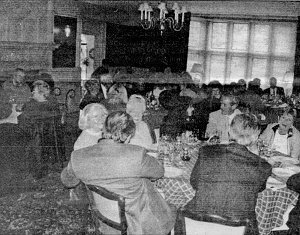 |
|
| The dining room was set with five round tables of 10 each. The food was served family style and came from Buon Gustaio in Glen Head. |
The 60-room mansion, which also has served as a country retreat for a branch of the Vanderbilt family sits amid squared lawns and formal English gardens on a heavily landscaped 127-acre estate in Old Brookville. It was in danger of becoming a subdivision when the company bought the property.
Cold weather kept guests from visiting the vineyards but Bob Whiting, estate and vineyard manager, gave a tour of the mansion for guests. He stood in front of a tall glass showcase, dubbed the "reliquary" which contains the relics of the late Saint Pope Pius X, including his silverware which was given to the Marianis by their great aunt, Teodolinda Banfi, who served at the Vatican as chief of the household staff of Pope Pius XI.
 |
|
| A view of the wood timbered reception room. The large oriental rug was made in Ireland. |
Mr. Whiting told a wonderful story about John Mariani's aunt and her sister who were orphaned and given to the family of a cardinal who raised them.
The showcase also has a giant clamshell about 6 million years old. Mr. Whiting quipped he was glad he wasn't the cave man who had to open it.
The estate's bucolic atmosphere is enhanced with a 75-acre chardonnay vineyard that was hand planted by Mariani family members. It features wide rows for grape picking machinery to ride through and turnarounds at the top of the aisles.
The Marianis own several estates in Europe as well as acres of vineyards. Banfi has built what is considered the most technologically advanced winery, and vineyards in Europe, perhaps the world.
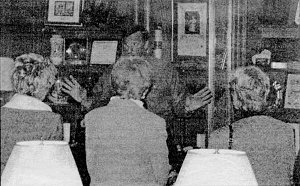 |
|
| Bob Whiting, estate and vineyard manager standing in front of the glass showcase containing Puis silverware given to the family by their great aunt Teodolinda Banfi, who worked in the Vatican. |
During his talk, Mr. Whiting related the Mariani's Italian-American family's history, making it a perfect place to continue the Oyster Bay Historical Society series.
The Freeholder
Tom Kuehhas, director of the Oyster Bay Historical Society has been working on a special edition of The Freeholder, which came out last week. It is a journal and the culmination of his project on the Italian-American Experience in Oyster Bay.
"I've heard wonderful stories. Those stories dragged me into the project. It's been an easy matter to put them into a format," he said.
"What has been so rewarding is that this, more then any other exhibit, has brought people to the museum during the week to see the displays. They usually come on the weekends," he said.
People come for all kinds of reasons. "One lady about 70, actually cried when looking at the exhibit of the things on loan. Her parents threw out everything because they wanted to be Americans. They thought it was a prerequisite to get rid of things from the old country. It brought her back in time with good and bad memories," he said.
Another plus has been the response from the Italian-American community. They have been very appreciative that it's being done and appreciative of the work that's gone into organizing the series, he said.
Mr. Kuehhas did about 20 taped interviews and for several others, he just took notes.
"The Freeholder has stories of the people who participated in the project: both stories and photographs.
"It was really a labor of love because I got to meet so many wonderful and interesting people. They didn't think they had interesting stories, but sometimes, my jaw dropped when they told me stories they thought were run of the mill."
Some of them are available on a kiosk of memories: a computer set up in the museum that contains snippets of interviews.
Mr. Kuehhas enjoyed hearing about the Italian Sunday meals and how the whole family would gather. "Unless your arm had been cut off and you were bleeding, you had to go.
"They gathered starting late in the morning and periodically ate a course, and went away and returned to the table over the day.
"Another great theme was wine making. Everyone had their own wine press and barrels and made their own wine. Men would go from house to house to press the grapes."
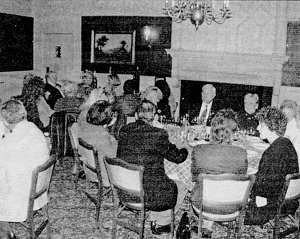 |
|
| Oil paintings and antiques were purchased by John F. Mariani, Banfi's chairman, and his wife Pamela on visits to historic homes and antique shops in London, Rome, Florence, Milan, Zurich and Geneva. "The last thing we wanted to create was a museum, but we wanted museum quality," said Pamela. |
At the luncheon at the Banfi Headquarters John LoRusso told a story about his father making wine in the cellar, at the urging of friends. He passed along the used mash to a friend who had a still and made Grappa.
At the luncheon Banfi served San Angelo Pinot Grigio from Montalcino, Tuscany; Centine Rosso di Toscana, Montalcino, Tuscany and a dessert wine: Rosa Regale Brachetto d'Acqui from Acqi Terme, Piedmont. It sells in the area of $25. The Brachetto grape it is made from has a higher sugar content than most and the taste is softened by the acidity of the alcohol, said Mr. Whiting. It was a favorite of the table.
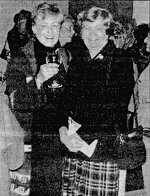 |
|
| Enjoying the Old Brookville Chardonnay Gold Coast 2000 are Jane Montgomery and her friend Joan Robertson. |
Mr. Kuehhas said, "Some Italians said that until they went to kindergarten, they spoke Italian at home. They lived in little enclaves and didn't learn how to speak English." He mentioned that was the case with Nick La Bella, Belle Principe Santora and some of the Abattes.
Mr. Kuehhas said, "History fascinates me because it is so cyclical. The lessons on how the Italians were treated can be translated to how the Spanish are seen today. As the Italians were seen as not assimilating, look at how well they have assimilated a couple of generations later, it is still a perception about immigrants.
"There were special enclaves of Italians. They lived in the Orchard area of Glen Cove and in Oyster Bay, they lived on Shore Avenue, Irving Place and School Street.
"The richness of the Italian culture is so striking/far reaching. When I was growing up, I lived in an area that was diverse as far as different European nationalities: German, Irish, Italian and Greek.
"I grew up eating lasagna, baked ziti and eggplant, and my mother wasn't Italian! She learned those recipes from friends.
"It's interesting since I grew up with Galantes, DeMarcos and Colovitos in Garden City South, near Adelphi College," he said.
"Maybe the foods are easy to assimilate because the ingredients are not costly. We also had German food," he added.
He has been enjoying the Italian project. "God has smiled on this project from the beginning," he said. Coming full circle he said the Banfi company was on board from the beginning.
"How can one of the most Italian businesses in the area not take part," he said.
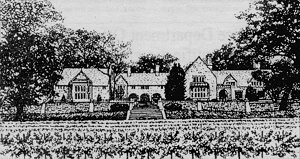 |
|
| Banfi Vintners, Old Brookville, America's leading wine importer and producer of premium wines in Tusacany and Piedmont, Italy. |
The Marianis obviously agreed. They were wonderful hosts and shared the beauty of their corporate headquarters with grace and warmth.
The Italian-American Experience in Oyster Bay continues with a roundtable discussion as longtime residents compare experiences of growing up in Italian-American communities on both the North Shore and South Shore of Long Island. It will take place on Nov. 30, starting at 4 p.m. It is co-sponsored by Dowling College, Oakdale in the old Vanderbilt mansion.
The program originally scheduled for Sunday, November 18, the Influence of the Roman Catholic Church on Italian-Americans has been canceled and will be rescheduled in February. Monsignor Charles Ribaudo, who is the moderator of the program canceled because of illness and another participant had a time conflict, said Mr. Kuehhas.
All proceeds from the series will benefit the Oyster Bay Historical Society's Building Fund. Call 922-5032 for reservations and directions.
Copyright © Oyster Bay Enterprise Pilot, November 15, 2001.
| Produced in the WebShop at SERVENET.COM. Please report bad or changed links to the WebMaster. Last update: 12/4/2001. |